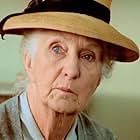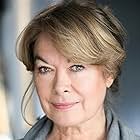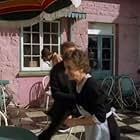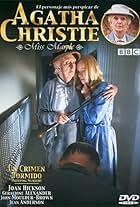IMDb RATING
7.6/10
2.2K
YOUR RATING
The normally friendly village of Lymston is plagued by vile anonymous letters. When a mother of three takes her own life, following such a letter, Ms. Marple is not at all convinced things a... Read allThe normally friendly village of Lymston is plagued by vile anonymous letters. When a mother of three takes her own life, following such a letter, Ms. Marple is not at all convinced things are as they seem.The normally friendly village of Lymston is plagued by vile anonymous letters. When a mother of three takes her own life, following such a letter, Ms. Marple is not at all convinced things are as they seem.
Browse episodes
Photos
Storyline
Did you know
- TriviaThe film differs from the book in several ways. Most significantly Miss Marple isn't called in until about 80% into the book.
- GoofsSomebody finds a book used for cutting out letters to make threatening notes. However, the print in this book is much smaller than the letters used in the notes.
- Quotes
Miss Jane Marple: When gentlemen of a certain age fall in love, they get the disease very badly.
- ConnectionsFollowed by Miss Marple: A Murder Is Announced (1985)
Featured review
The Moving Finger sees brother and sister Gerry and Joanna Burton (Andrew Bicknell and Sabina Franklyn) move to a quiet English village for Gerry to recooperate after injuries sustained in a car accident. Everything seems hunky dory and all so ordinary, but pretty soon they receive a poison pen letter. It turns out that a number of the villagers have received them, but little do they suspect that before long it will result in a death. And when it does, it is Miss Marple who suspects there may be a far more sinister cause behind it all.
My first encounter with the story was the actual novel some years ago. I can't remember it that clearly, but I know I enjoyed the book. And this serves up as a decent adaptation, creating an ordinary quiet village community of the post war period where it seems unlikely that anything untoward could ever happen. That it does makes it all the more intriguing. There's the village doctor Owen Griffith and his sister Eryl, vicar Rev Calthrop and his wife Maud, solicitor Edward Symmington and his wife and children, including awkward tomboy Megan Hunter, plus spinster Miss Barton (whose house the siblings rent out while Gerry recovers) and waspish Mr Pye, a man who lives on his own in a grand house. For me when reading the book I immediately thought of Richard Pearson as Mr Pye, so when I finally got to see this adaptation I was delighted to find him playing the part. He is perfect in the role. His character is clearly gay but without overstating it as they do in modern adaptations of period dramas, he is seemingly affable at first but soon flexes his critical claws when he gets talking. He makes Mr Pye both a slightly camp character and at the same time also sinister, which is perfect when trying to create the possibilities of who the poison pen writer may be. Also good is Michael Culver as Symmington, the cultured solicitor who all the village women like working for. His understated acting gives an added edge of quality and realism to the proceedings just by keeping it ordinary, but he still keeps your attention regardless. And then there is Hilary Mason as Miss Barton, who can conjur up sinister just by her appearance in Don't Look Now (1973). Here she is a genteel spinster of the Victorian generation, still coming to terms with the new world, and Mason plays it beautifully. But is her character actually just an act hiding something more macabre?
Indeed, I have to say the support cast probably make more of an impact than the main leads, though both Bicknell and Franklyn do well enough as the brother and sister. There is little really at fault with the cast performances, though some - like John Arnatt's vicar - are somewhat bland, and I could of done without the 'comic' turn of Victor Maddern's policeman, despite loving him in the Carry ons. But it's Deborah Appleby's role as Megan that is a little conflicting for me. She's decent enough in the role, but she looks way too old to be playing a girl of 20. It's nice the writers stayed faithful to the novel and didn't decide to sex her up for the TV version, which makes her character so interesting from the usual glamorous "girl in peril" parts. But at times Appleby looks a little awkward in the role, and not just because her character is supposed to be. And there is one scene where Gerry whisks her off for a surprise makeover that looks decidedly cheap. Instead of seeing footage of her being done up, it inserts montage snaps of the event that robs us somewhat of her moment. It's surprising the makers chose to do that, considering the lavish treatment they have done in recreating the past in both costume and sets.
I reiterate that it is a good adaptation, intriguing to the viewer. But that's what puzzles me - it's intriguing, rather than absorbing, and I can't put my (moving) finger on just why. Maybe it's because the suspects are so everyday they struggle to make this mystery truly stand out. Yet there are moments in this that stay in the memory, both involving poor tragic maid Beatrice (played by Juliet Waley, who I remember from Look & Read's Dark Towers). The first is the image of her waiting fretfully for her boyfriend to turn up among a series of scenes about the village as it builds up to the first murder. The second is when Megan eventually discovers poor Beatrice, with the scene notably effective and creepy. Indeed, it is even more effective than the fate of another maid in A Pocketful of Rye which I do recall as a kid (what DID Agatha Christie have against domestics?). And considering sometimes they say crime writers don't play fair with the viewers, there is a remarkable scene where it practically shows the killer placing the book used for the poison pen letters to plant on another villager, but you don't realize this until the culprit is later exposed. Talk about having confidence in your direction, but it works neverhtless. And at least this time Joan Hickson's character is introduced into the story more naturally, paying a visit to old friend Maud Calthrop (Dilys Hamlett) who happens to relay about the poison pen letters to her in conversation.
So an intriguing mystery overall, and enjoyable to watch. But for some reason it doesn't feel in the same quality as the truly great Miss Marple mysteries. And I really can't put my finger on why.
My first encounter with the story was the actual novel some years ago. I can't remember it that clearly, but I know I enjoyed the book. And this serves up as a decent adaptation, creating an ordinary quiet village community of the post war period where it seems unlikely that anything untoward could ever happen. That it does makes it all the more intriguing. There's the village doctor Owen Griffith and his sister Eryl, vicar Rev Calthrop and his wife Maud, solicitor Edward Symmington and his wife and children, including awkward tomboy Megan Hunter, plus spinster Miss Barton (whose house the siblings rent out while Gerry recovers) and waspish Mr Pye, a man who lives on his own in a grand house. For me when reading the book I immediately thought of Richard Pearson as Mr Pye, so when I finally got to see this adaptation I was delighted to find him playing the part. He is perfect in the role. His character is clearly gay but without overstating it as they do in modern adaptations of period dramas, he is seemingly affable at first but soon flexes his critical claws when he gets talking. He makes Mr Pye both a slightly camp character and at the same time also sinister, which is perfect when trying to create the possibilities of who the poison pen writer may be. Also good is Michael Culver as Symmington, the cultured solicitor who all the village women like working for. His understated acting gives an added edge of quality and realism to the proceedings just by keeping it ordinary, but he still keeps your attention regardless. And then there is Hilary Mason as Miss Barton, who can conjur up sinister just by her appearance in Don't Look Now (1973). Here she is a genteel spinster of the Victorian generation, still coming to terms with the new world, and Mason plays it beautifully. But is her character actually just an act hiding something more macabre?
Indeed, I have to say the support cast probably make more of an impact than the main leads, though both Bicknell and Franklyn do well enough as the brother and sister. There is little really at fault with the cast performances, though some - like John Arnatt's vicar - are somewhat bland, and I could of done without the 'comic' turn of Victor Maddern's policeman, despite loving him in the Carry ons. But it's Deborah Appleby's role as Megan that is a little conflicting for me. She's decent enough in the role, but she looks way too old to be playing a girl of 20. It's nice the writers stayed faithful to the novel and didn't decide to sex her up for the TV version, which makes her character so interesting from the usual glamorous "girl in peril" parts. But at times Appleby looks a little awkward in the role, and not just because her character is supposed to be. And there is one scene where Gerry whisks her off for a surprise makeover that looks decidedly cheap. Instead of seeing footage of her being done up, it inserts montage snaps of the event that robs us somewhat of her moment. It's surprising the makers chose to do that, considering the lavish treatment they have done in recreating the past in both costume and sets.
I reiterate that it is a good adaptation, intriguing to the viewer. But that's what puzzles me - it's intriguing, rather than absorbing, and I can't put my (moving) finger on just why. Maybe it's because the suspects are so everyday they struggle to make this mystery truly stand out. Yet there are moments in this that stay in the memory, both involving poor tragic maid Beatrice (played by Juliet Waley, who I remember from Look & Read's Dark Towers). The first is the image of her waiting fretfully for her boyfriend to turn up among a series of scenes about the village as it builds up to the first murder. The second is when Megan eventually discovers poor Beatrice, with the scene notably effective and creepy. Indeed, it is even more effective than the fate of another maid in A Pocketful of Rye which I do recall as a kid (what DID Agatha Christie have against domestics?). And considering sometimes they say crime writers don't play fair with the viewers, there is a remarkable scene where it practically shows the killer placing the book used for the poison pen letters to plant on another villager, but you don't realize this until the culprit is later exposed. Talk about having confidence in your direction, but it works neverhtless. And at least this time Joan Hickson's character is introduced into the story more naturally, paying a visit to old friend Maud Calthrop (Dilys Hamlett) who happens to relay about the poison pen letters to her in conversation.
So an intriguing mystery overall, and enjoyable to watch. But for some reason it doesn't feel in the same quality as the truly great Miss Marple mysteries. And I really can't put my finger on why.
- gingerninjasz
- Jun 21, 2023
- Permalink
Details
- Release date
- Countries of origin
- Languages
- Also known as
- Miss Marple - Die Schattenhand
- Filming locations
- Hoxne, Suffolk, England, UK(Lympston village)
- Production companies
- See more company credits at IMDbPro
Contribute to this page
Suggest an edit or add missing content

Top Gap
By what name was Miss Marple: The Moving Finger (1985) officially released in India in English?
Answer

























